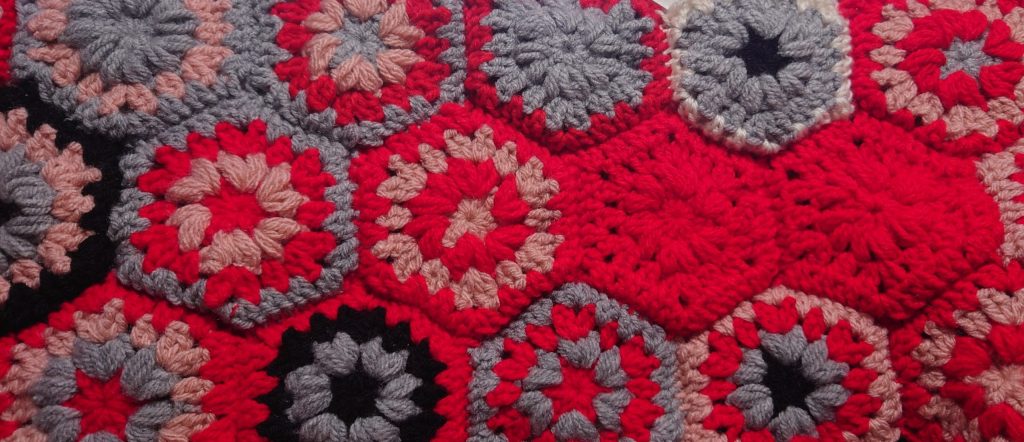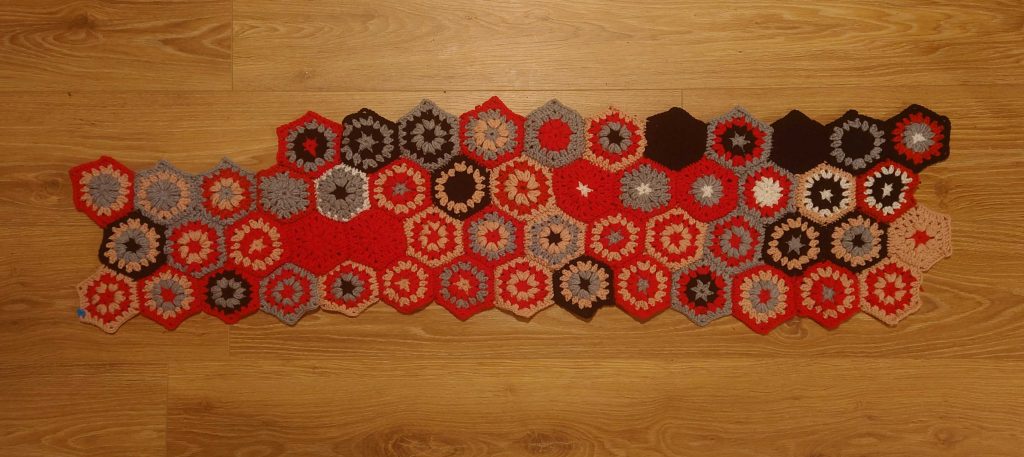
Hiya, I’m Leah and I’m one of the peer support workers on the Beyond Diagnosis service. I’ve been working at Bipolar Scotland for just under a year now and living with a bipolar diagnosis for 11 years. Mood tracking has been recommended to me often since I was diagnosed back in 2012. Whilst I’ve tried lots of different options that have worked for others, nothing has been engaging enough for me to stick with it longer than a few months at a time. However I’ve recently started a mood-tracking technique that works for me, is creative and I wanted to share it with as many people as I can. I’m referring to this technique as my mood blanket.

Mood tracking can be really useful for a lot of reasons. It can help identify triggers and makes it easier to go into psychiatry appointments able to accurately describe my mood changes since we last spoke. Tracking can also help with identifying when moods are changing to put in place coping mechanisms or well-being plans, which can help stop them from becoming more serious episodes. I also find that keeping track of patterns in mood changes can help with planning for the future, and most importantly for me, it helps me notice how medication changes have affected me. I find this a lot easier when I track my moods after changing medication or dose.
There are thousands of apps available to track mood, lifestyle, sleep and all sorts of other things. One of my peers uses the Bipolar UK app and loves it. If that doesn’t work for you, there are so many other ones to try that it’s likely there’s one to suit most people. Using a physical journal or diary to keep track of moods is another way to do it. This can be a simple sentence or drawing that describes your mood each day or week, or it can be used as a way to get out all your feelings and thoughts whilst also logging your mood.
There are many different worksheets or workbooks online that can be used to track mood with a view to sharing them with your mental health team or doctor … or you can get more creative with it!

I don’t imagine I’m the first person ever to come up with the idea of a mood blanket, or some way of journaling mood tracking creatively. However, I first thought of it when my friend was talking about starting a temperature blanket for 2023. A temperature blanket, she told me, is a project where you crochet a segment of blanket every day of the year corresponding to the temperature on that day where you live. You might decide to choose blues for cold and reds for warm, but that’s not necessarily the only choice. At the end of the year, you’d have 365 segments all linked together into a blanket, showing the passing seasons and temperatures. I thought that was exciting, but almost immediately thought of other things I could track than temperature and my first thought was my mood.
I’ve tried so many ways of tracking my moods over the years and it always falls off after a little while because I forget, it’s time-consuming or if I’m using a physical journal I lose it, or apps stop working. I’ve had some success with just drawing a happy or sad face on my calendar each day- but that’s hard to look at and identify patterns. Journaling I find similarly difficult to look at as an overview. I want to be able to identify long periods of low or high mood and it’s not easy to do that with some methods.
Apps can be a great way of mood tracking – you can have them remind you once a day, log a huge amount of information on sleep, mood, eating, and lifestyle details, and then get a handy graph or other output that shows sweeping mood changes.It can be really helpful – but also a bit boring for me, and the more information you’re trying to track the longer it takes. It is a great option for most people if you’re looking to track your moods and get seriously useful data out of it.
But for me, I wanted something that I could see as an overview, was creative or engaging in some way and also something that might stimulate conversation about my mental health or allow others around me to see my mood so that they can better support me.
The way that I chose to do this became my mood blanket. I started it on the 1st of January 2023 and whilst I’ve fallen behind a few times and had to catch up, it takes me less than half an hour to complete them and I have every intention of keeping it up for the rest of the year. The hexagon pattern I chose came from a website called SassySheep and is called a ‘Primrose Temperature Blanket pattern’. There are infinite numbers of different ways to pattern out a mood blanket though, so doing a bit of googling on temperature blanket patterns would be a great idea for someone wanting to start one. It can be as simple or complex as you want.

My colour choices were fairly simple and I think self-explanatory. I went with red as my favourite colour for my ‘stable’ choice, where I am neither depressed nor particularly happy.
Black- Dangerously depressive mood
Grey- Sad mood
Red- Stable mood
Pink- Happy/ excited mood
White- Dangerously high mood
Ideally, my blanket would be a mix of red and pink, but the different colours coming through are so very useful to me for all the reasons I mentioned above. I could also have chosen to have ten different colour variations or only three, I decided on 5 colours as a happy medium but there’s no right or wrong way to do this.
I have psychology sessions weekly at the moment and I often find myself looking at my blanket to remind me when she inevitably asks me how my week has been and I can’t remember. I have my first psychiatry appointment of the year in May, and using my blanket as a way to talk him through my mood changes over the last 5 months will be incredibly useful with no graphs or flicking through pages of a journal required.

No! I was at a very basic level with my crochet skills before I started my mood blanket. The pattern I’ve chosen is a little more complicated than others, but some people just crochet a line, a square, or a few stitches. There are no guidelines on what you must be able to crochet to keep track of your mood creatively with a mood blanket. Because it’s the same every day as well, within a week or so I became very comfortable with my little hexagons, so no, I don’t think you have to be an expert from the beginning at all.

My mood blanket is a great choice for me because it shows me in a very creative way what my moods have been like across the year so far and because it’s creative I feel better about posting it on my social media than I might otherwise. This involves the people around me in my mental health, which I think is a huge move in the right direction for being able to be supported by my friends and family.
It’s gotten to the stage now in the year that my friends pop up with, “I noticed yesterday was a black and grey day, are you okay?” Or, “I’m so glad you had a pink day yesterday!” There’s also been a few times where my mood has been too low to want to crochet at all, and noticing that I haven’t posted anything was also a way for the people around me to realise that maybe I’m in a place where I need some extra support.
Going forward, I plan to make tracking my mood creatively a part of my daily routine. Getting involved in making a mood blanket is easy because as I said before, there’s no right way to do it. I think the arts and crafts and other creative hobbies are so great for my mental health in general that linking the two in this way is an incredibly useful tool.
All you need is:
There’s no reason to share if you’re not comfortable with that, or at least not to share your colour choices or the reasons behind your blanket. It can be a personal thing or something to involve your friends and family in, but most importantly I think it’s a chance to be introspective and creative while making an effort to learn about and ultimately help to control your mood episodes.
 1098
1098Stories
"*" indicates required fields

On The Level, our bi-monthly e-magazine for people in Scotland living with bipolar, is packed full of articles, case studies, news and opportunities to take part in research. Why not sign up to receive it and join the caring, informed Bipolar Scotland community?
Thank you for this. I appreciate your creativity and your very thorough and inclusive explanation of, what, why and how. Best wishes. Kay B.